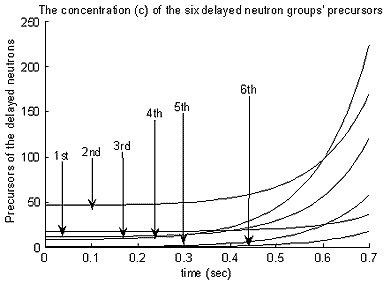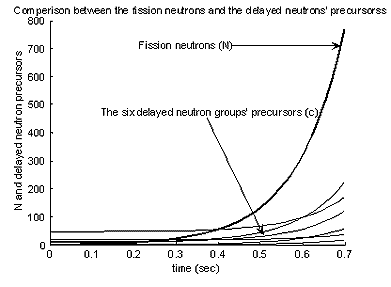 |
 |
Issue No.13 Summer
|
| ENS News |
| ENS Events |
| Member Societies & Corporate Members |
| Petten research reactor converts to using low-enriched fuel Neutron Kinetics of the Chernobyl Accident Nuclear Option in Countries with Small and Medium Electricity Grids |
YGN Report |
| European Institutions |
| MEP Forum discusses economics of nuclear energy |
| ENS World News |
ENS Members |
| Links to ENS Member
Societies Links to ENS Corporate Members Editorial staff ______________________ |
| _____________________ |
 TopSeal 2006 17.9. - 20.9.2006 Olkiluoto, Finland |
| _____________________ |
 TopFuel 2006 22 - 26 October 2006 in Salamanca |
| _____________________ |
| _____________________ |
|
|
|
|
and |
|
Here
t time (sec)
N neutron flux (proportional to the reactor power)
![]() k change
of the effective neutron multiplication factor (keff)
k change
of the effective neutron multiplication factor (keff)
ß sum of the delayed neutron fractions (here 0.006502)
ßi the i:th delayed neutron fraction
l neutron mean lifetime (here 0.001 sec)
![]() i i:th
decay constant (sec-1)
i i:th
decay constant (sec-1)
ci concentration of the i:th fraction of the delayed neutrons’
precursors,
At steady state, when time is zero t=0 all time derivatives are
equal to zero,
all d/dt=0 and the initial value of the relative power equals
unity N(0)=1, and also
no reactivity perturbation is present ![]() k=0
k=0
N(0)=1 |
 |
Delayed neutron data for thermal fission in U235 is used
Group |
1 |
2 |
3 |
4 |
5 |
6 |
Fraction ßi |
0.000215 |
0.001424 | 0.001274 | 0.002568 | 0.000748 | 0.000273 |
Decay constant |
0.0124 |
0.0305 |
0.111 |
0.301 |
1.14 |
3.01 |
The initial values of the delayed neutrons’ precursors are;
i |
1 |
2 |
3 |
4 |
5 |
6 |
| ci(0) |
17.3387 |
46.6885 |
11.4775 |
8.5316 |
0.6561 |
0.0907 |
If you are interested in the MATLAB code used to generates the figures below, please click on the following link
The result
Is given in the following plot

It is obvious that, the more positive the void coefficient is, the faster the power is increasing. When the void coefficient is zero the power is not increasing at all. The Western type boiling water reactors have strong negative void coefficient meaning that a similar transient would quickly lead to the shut down of the reactor by itself
Delayed neutrons
To study the course in time of the concentration of the delayed neutrons’ precursors (c1 to c6) is also interesting. The following plot is for +30 pcm/% void coefficient showing the colons 2 to 7 of the x matrix

It is clear that the precursor concentration
of the fastest growing group of the delayed neutrons is the 6th
where the decay constant is the largest [![]() 6=3.01]
and the largest concentration of the delayed neutron’s precursors
at time zero is the 2nd group [c2(0)=46.6885]
6=3.01]
and the largest concentration of the delayed neutron’s precursors
at time zero is the 2nd group [c2(0)=46.6885]
To compare the evaluation of the behaviour in time of the fission neutrons and the six groups of delayed neutrons’ precursors at +30 pcm/% void coefficient all seven colons of the x matrix are plotted here

Remarkably at the beginning of the transient [t=0] some of the delayed neutrons’ precursors [c1(0), c2(0), c3(0), c4(0)] are larger than the fission neutrons’ flux [N(0)=1], while later, as the transient evolves the fission neutrons overwhelm grossly the delayed neutrons’ precursors as expected.
Neutron Kinetics of the Chernobyl Accident
Frigyes Reisch
Nuclear Power Safety
KTH, Royal Institute of Technology
Stockholm, Sweden
| |

